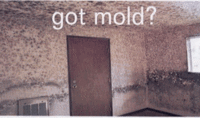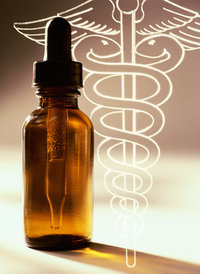Once we have accurately determined what you are allergic to, we will work to both limit your exposure and lessen your sensitivity (or reactivity).
Lessening Exposure
 Reducing your exposure to molds includes many simple things such as reducing humidity and changing filters, to more complex administration of antifungal medications. Some useful steps include:
Reducing your exposure to molds includes many simple things such as reducing humidity and changing filters, to more complex administration of antifungal medications. Some useful steps include:- Try to reduce humidity in the home environment. Use a dehumidifier in the house or turn up the air conditioner, changing the air filter frequently.
- Remove any visible mold stains from the surface of wet areas, such as the bathroom, with a fungicidal agent.
- Avoid the overuse of antibiotics; consider using antifungals in combination when necessary.
- Consider a diet low in molds and complex carbohydrates.
- Fix leaky roofs and/or wet walls.
- Consider removing carpet from cement floors.
- Do not rake leaves or hay.
- Consider using an air cleaner with a HEPA filter in the bedroom. Make sure the machine is well maintained.
- Do not allow children to lie on the carpet at home.
- Make sure all rooms in the house or workplace are well ventilated.
- Remember that air conditioning units in cars can harbor molds. Allow the air conditioner to run for 10 minutes before rolling up the windows.
- Clean the air duct system in the house or building periodically, especially in humid regions.
Because irrigation must get into the sinuses in order to be effective, we often need to perform endoscopic sinus surgery to open up the sinuses. However, it may be possible to irrigate the sinuses effectively without surgery by using an irrigation device such as the Grossan irrigator or a bulb syringe.
Some doctors have added antifungals (or antibiotics) to the Grossan irrigator. One method is to add 1 tsp of salt (or Breathease, or salt-baking soda solution) to 500 cc of water in the Hydropulse and irrigate. When the solution is almost gone, it is possible to add the antifungal to the irrigation fluid and continue irrigating. The antifungal solution should not be added at the beginning because it may become too diluted.
Currently, patients are being treated with irrigation with topical antifungals such as Amphotericin B. The Mayo clinic has found that 75% show improvement. A paper was presented at the AmericanAcademy of Allergy, Asthma and Immunology meeting in 2004, which compared six months of irrigation with Amphotericin (250 micrograms/ml) vs. a placebo. There was a statistically significant difference in the amount of mucosal thickening on the CT scan as well as endoscopic scores. In addition, there were changes in levels of interleukin-5 and eosinophil-derived neurotoxin.
Although when given intravenously there are serious side effects with Amphotericin B, topically it causes minimal problems. These can include burning due to the fact that it must be mixed with sterile water. It cannot be mixed with saline, and must be protected from light and refrigerated. It is therefore very inconvenient to use. More acceptable formulations are being evaluated. We anticipate that patients will need to be treated indefinitely, or at least until we understand better why these problems are occurring.
Itraconazole (Sporanox) can also be used topically, but it is very difficult to make up since most mixtures cause the itraconazole to be inactivated immediately. Although many pharmacies claim to be able to make up the itraconazole, almost all pharmacies are unable to make it up correctly and be able to ensure that there is active drug in the mixture. It must be made up by Anazao pharmaceuticals or Sinucare. Nystatin can be used with impunity, as it has no significant systemic absorption.
Oral antifungals have shown a great deal of promise as well. The well-respected allergy group in Lacrosse Wisconsin, who also champions Sublingual mold desensitization, has had success with Diflucan on a bi-weekly basis.
Some patients seem to respond to treatment with other oral antifungals, including Sporanox, Lamisil and possibly Nizoral. We are currently working on other treatments, which we hope will be available in the near future.
For more information, see our section on Advanced Medical Treatment.
Lessening Reactivity (Desensitization)
 After minimizing fungal exposure, we must look toward diminishing the body’s immunologic reaction to the fungi. Steroids are paramount in reducing reactivity and fighting inflammation. Systemic steroids work very well, but unfortunately due to the side effect profile, cannot be used indefinitely. Topical steroids are somewhat helpful and should always be part of the treatment regimen.
After minimizing fungal exposure, we must look toward diminishing the body’s immunologic reaction to the fungi. Steroids are paramount in reducing reactivity and fighting inflammation. Systemic steroids work very well, but unfortunately due to the side effect profile, cannot be used indefinitely. Topical steroids are somewhat helpful and should always be part of the treatment regimen.We like to think of immunotherapy as trying to give you the benefits of systemic steroids without the side affects. It is speculated by some that since most of patients with chronic sinusitis have a positive allergy skin test for fungi or mold, it may be possible to treat them by standard allergy management. Since we cannot allergy test for all of the fungi, it can be a difficult proposition, but we now test and give allergy immunotherapy for a much larger number of molds and fungi. We also have found that mold allergy patients in particular respond very well to Sublingual Immunotherapy (SLIT).
In conclusion, when looking at any patient with chronic rhinosinusitis we at least need to think about fungi. Fungi are just about everywhere and fungal hypersensitivities (both allergic and cell mediated) seem to be a major cause of CRS. The best way to get an accurate diagnosis is with a detailed history and intradermal dilutional skin testing to a large number of molds. We then can begin a personalized treatment based on avoidance, pharmacotherapy (antifungals), nasal irrigations, desensitization, and possibly surgery. Most patients can be helped.